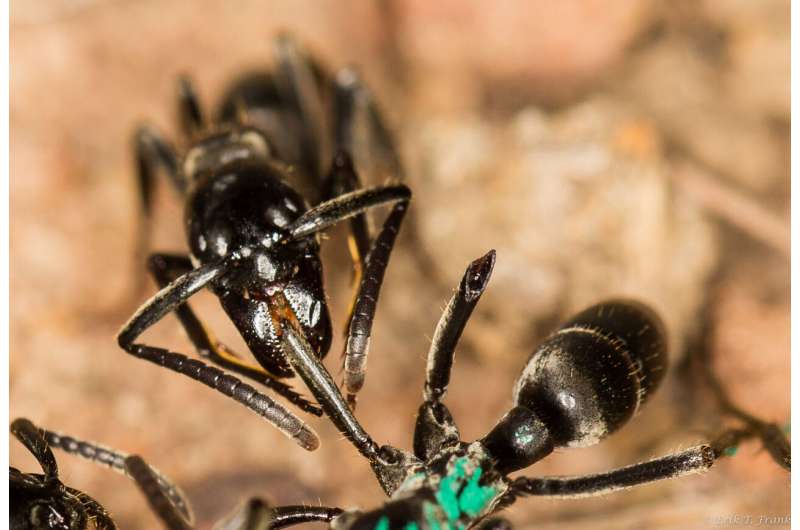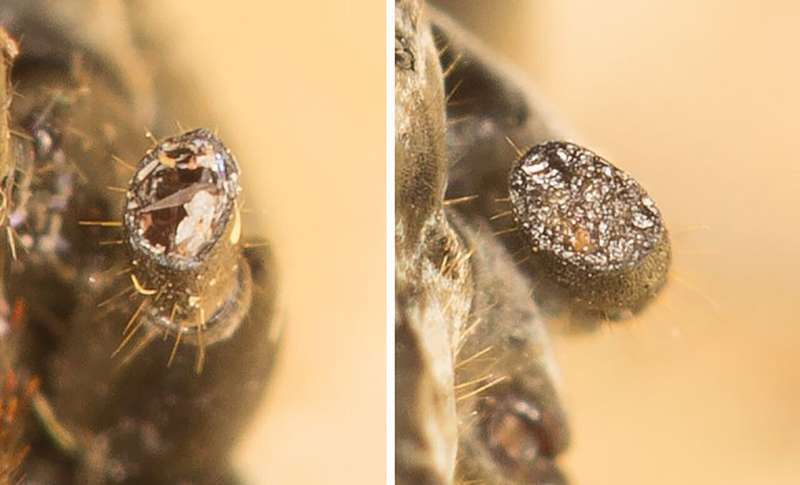This article has been reviewed according to Science X's editorial process and policies. Editors have highlighted the following attributes while ensuring the content's credibility:
fact-checked
peer-reviewed publication
trusted source
proofread
Matabele ants recognize infected wounds and treat them with antibiotics

The African Matabele ants are often injured in fights with termites. Their conspecifics recognize when the wounds become infected and initiate antibiotic treatment.
The Matabele ants (Megaponera analis), which are widespread south of the Sahara, have a narrow diet: They only eat termites. Their hunting expeditions are dangerous because termite soldiers defend their conspecifics—and use their powerful mandibles to do so. It is therefore common for the ants to be injured while hunting.
If the wounds become infected, there is a significant survival risk. However, Matabele ants have developed a sophisticated health care system: They can distinguish between non-infected and infected wounds and treat the latter efficiently with antibiotics they produce themselves. This is reported by a team led by Dr. Erik Frank from Julius-Maximilians-Universität (JMU) Würzburg and Professor Laurent Keller from the University of Lausanne in the journal Nature Communications.
Treatment drastically reduces mortality
"Chemical analyses in cooperation with JMU Professor Thomas Schmitt have shown that the hydrocarbon profile of the ant cuticle changes as a result of a wound infection," says Erik Frank. It is precisely this change that the ants are able to recognize and thus diagnose the infection status of injured nestmates.
For treatment, they then apply antimicrobial compounds and proteins to the infected wounds. They take these antibiotics from the metapleural gland, which is located on the side of their thorax. Its secretion contains 112 components, half of which have an antimicrobial or wound-healing effect. And the therapy is highly effective: The mortality rate of infected individuals is reduced by 90%, as the research group discovered.

Analysis of ant antibiotics is planned
"With the exception of humans, I know of no other living creature that can carry out such sophisticated medical wound treatments," says Erik Frank. Laurent Keller also adds that these findings "have medical implications because the primary pathogen in ant's wounds, Pseudomonas aeruginosa, is also a leading cause of infection in humans, with several strains being resistant to antibiotics."
Are Matabele ants really unique in this respect? The Würzburg researcher now wants to explore wound care behaviors in other ant species and other social animals. He also wants to identify and analyze the antibiotics used by Matabele ants in cooperation with chemistry research groups. This may lead to the discovery of new antibiotics that could also be used in humans.
Matabele ants in a Netflix documentary
A few years ago, Erik Frank's research into the African ants that care for their injured nestmates sparked the interest of a film production company. The company was commissioned by Netflix to find exciting stories for the eight-part nature documentary "Life on Our Planet," which focuses on the evolution of life over the past 500 million years.
After six years of work, the series can now be seen on Netflix. It was produced by Steven Spielberg and the English version is narrated by actor Morgan Freeman. The series has been translated into German and numerous other languages. The Matabele ants appear in the fifth episode, which is called "In the Shadow of Giants" and lasts 51 minutes.
The sequence about Erik Frank's ants was filmed in April 2021 at the Comoé research station of the University of Würzburg in Côte d'Ivoire. "It took three weeks, the effort was enormous," says the JMU researcher. The film was shot in the ants' natural habitat, but also in artificial nests in the research station's laboratory, and Erik Frank's expertise was in constant demand during this time.
More information: Erik. T. Frank et al, Targeted treatment of injured nestmates with antimicrobial compounds in an ant society, Nature Communications (2023). DOI: 10.1038/s41467-023-43885-w
Journal information: Nature Communications
Provided by Julius-Maximilians-Universität Würzburg




















